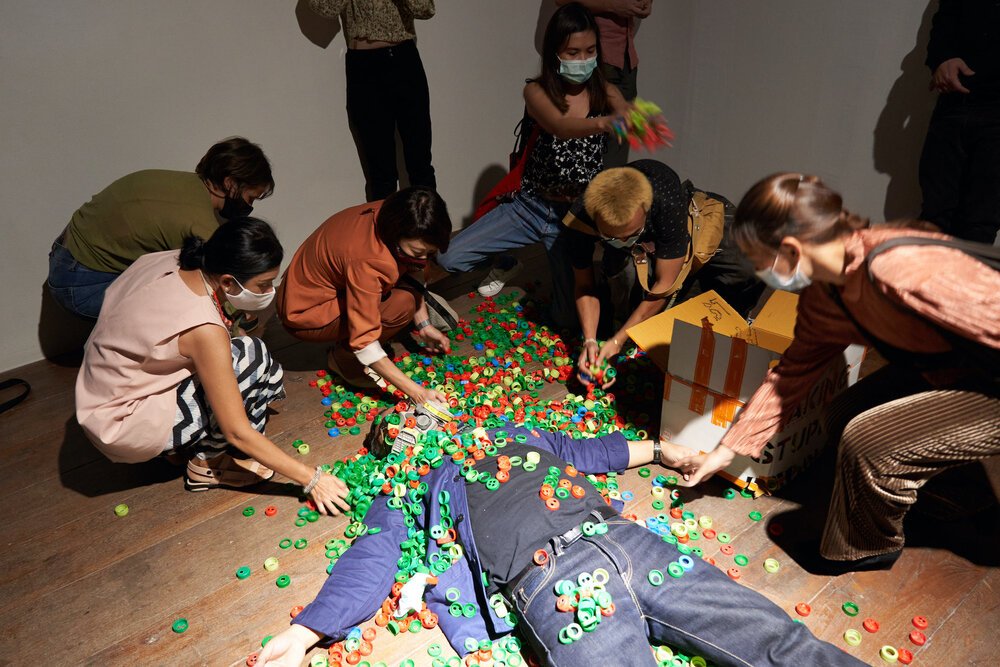‘Homecoming / Eventually’ at UP Vargas Museum
Virtual Spaces by Nontawat Numbenchapol and Ryan Villamael
By Christian Lemuel Magaling
This is a winning entry from the inaugural Art & Market ‘Fresh Take’ writing contest. For the full list of winners and prizes, click here.
Much of the historical drivers of Southeast Asia’s nation-building in mid-20th century was marred by exclusions building around ethnic majorities.1 Most of these imperial structures were inherited from respective colonial rules. Visual narratives that are conscious of these regional challenges could counteract the determination of unnatural borders comfortably disappearing in collective memory. The origin of the term “Southeast Asia” designated for military administration encouraged the funding and support of area studies in the west throughout the Cold War due to military interest in the region.2
‘Homecoming/Eventually’ by Nontawat Numbenchapol (b. 1983) and Ryan Villamael (b. 1987) is a response to the conditions cohabited in the wave of arrivals of overseas nationals in the time of the pandemic.3 These “homecomings” were predisposed to the multilateral tensions in the movement of warm bodies from international airports to special economic zones situated within the milieu of gentrified protests and privatised identities. The two works are a balanced representation of Mainland and Maritime Southeast Asia. Each has its own border issues and disputes within the terrain of nation-building, while its history is still being written.4 Lifting this subject from the pages of history creates a more nuanced view of its effects in forming habits of looking at contemporary events that shape people’s movement.
Nontawat Numbenchapol, ‘Mr Shadow’, 2016-17, C-Print mounted on archival paper, 111x167 cm. Image courtesy of UP Vargas Museum.
The depersonalised appeal of invisibility in Numbenchapol’s ‘Mr Shadow’ (2021) has removed the intimidation of force despite the generous presence of uniforms of servicemen. The fatigue uniforms act as an antipode which is supposed to hide combatants in plain sight. In this case, it functions to reveal the disappeared body’s contours. There is a feeling of alienation in the mysterious poses at rest, which are mostly drawn to the ground, disarmed in advance by the tranquility. The ruggedness of the uniforms also reveals aspects of class components in Thailand’s military elite. While the upper echelons of Thailand’s military enjoy political privileges, Numbenchapol has demonstrated before the viewers the disparities inherent on the ground.
Ryan Villamael, ‘Terrain, After’, 2019, acid-free paper, 68 x 269 cm. Image courtesy of UP Vargas Museum.
Villamael’s ‘Terrain, After’ (2019) at a distance outlines a wall of mountain as its middle-ground; its fortitude is supported only by the brittle paper. Since it is slightly embossed from the wall, its texture immediately communicates frailty. The sand that serves as its base suggests the limits of its form, which appears to be vulnerable in the viewers’ movement as it can carry away particles of sand if one attempts to look at the fine details of the image. Its remaining composure is deposed to the tautness of experience. Looking at it is a practice in restraint, balancing the precarious experience between materiality and perception. It creates a sense of incompleteness expressed in the negative space outlined by two different materials.
Locus Amoenus
Installation view of ‘Locus Amoenus’ (2021). Image courtesy of UP Vargas Museum.
‘Locus Amoenus’ (2021) is the most noticeable of all installations and yet easiest to disregard as it dissolves into the background. The material of this seemingly ornamental flora are colonial maps hanging from the ceiling. These cut-outs of colonial maps resemble wild tropical plants which look as if they are trying to prey on unsuspecting guests as they reach downward.
A closer look at Villamael’s ‘Locus Amoneus’ (2021) made from cutout of colonial maps. The installation hangs around the different parts of the museum. Villamael translates his concepts using fragile materials as medium in communicating the complexities of urban living and different historical forms.
The opinions, findings, and conclusions or recommendations expressed herein are those of author(s) and do not necessarily reflect the view of the ASEAN Foundation, ASEAN Secretariat, and ASEAN-Korea Cooperation Fund.
The views and opinions expressed in this article are the author's own and do not necessarily reflect those of A&M.
1 Amrith, S. (2014). Ethnicity in post-colonial Southeast Asia. In Routledge Handbook of Southeast Asian History (pp. 290-300). Routledge.
2 Cumings, B. (2002). Boundary displacement: The state, the foundations, and area studies during and after the Cold War. In Learning Places (pp. 261-302). Duke University Press.
3 Loredana Pazzini-Paracciani, (2021). UP Vargas Museum. Retrieved: https://stayhappening.com/e/homecoming-eventually-E2ISTMVK9NS
4 Wang, G. (Ed.). (2005). Nation-building: five Southeast Asian histories. Institute of Southeast Asian Studies.
5 Hau, C. S. (2014). Privileging Roots and Routes Filipino Intellectuals and the Contest over Epistemic Power and Authority. Philippine Studies Historical & Ethnographic Viewpoints, 29- 65.
About the Writer
Christian Lemuel Magaling is an independent researcher. He was part of the 13th AGSF at ARI-NUS, and was a research fellow at the Faculty of Geography & History, University of Valencia in 2019. Currently, he is a recipient of the Individual Research Award by the NCCA.

















